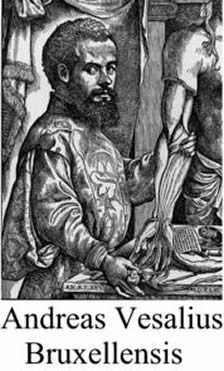This article is part of the series "A Moment in History" where we honor those who have contributed to the growth of medical knowledge in the areas of anatomy, medicine, surgery, and medical research.

Andreas Vesalius Bruxellensis (1514- 1564). A Flemish anatomist and surgeon, Andreas Vesalius was born on December 31, 1514 in Brussels, Belgium. He is considered to be the father of the science of Anatomy. Up until his studies and publications human anatomy studies consisted only on the confirmation of the old doctrines of Galen of Pergamon (129AD - 200AD). Anatomy professors would read to the students from Galen's work and a demonstrator would point in a body to the area being described, if a body was used at all. The reasoning was that there was no need to dissect since all that was needed to know was already written in Galen's books. Vesalius, Fallopius, and others started the change by describing what they actually saw in a dissection as opposed to what was supposed to be there.
Vesalius had a notorious career, both as an anatomist and as a surgeon. His revolutionary book "De Humani Corporis Fabrica: Libri Septem" was published in May 26, 1543. One of the most famous anatomical images is his plate 22 of the book, called sometimes "The Hamlet". You can see this image if you hover over Vesalius' only known portrait which accompanies this article. Sir William Osler said of this book "... it is the greatest book ever printed, from which modern medicine dates"
After the original 1543 printing, the Fabrica was reprinted in 1555. It was re-reprinted and translated in many languages, although many of these printings were low-quality copies with no respect for copyright or authorship.
The story of the wood blocks with the carved images used for the original printing extends into the 20th century. In 1934 these original wood blocks were used to print 617 copies of the book "Iconaes Anatomica". This book is rare and no more can be printed because, sadly, during a 1943 WWII bombing raid over Munich all the wood blocks were burnt.
One interesting aspect of the book was the landscape panorama in some of his most famous woodcuts which was only "discovered" until 1903.
Vesalius was controversial in life and he still is in death. We know that he died on his way back from a pilgrimage to Jerusalem, but how he died, and exactly where he died is lost in controversy. We do know he was alive when he set foot on the port of Zakynthos in the island of the same name in Greece. He is said to have suddenly collapsed and die at the gates of the city, presumably as a consequence of scurvy. Records show that he was interred in the cemetery of the Church of Santa Maria delle Grazie, but the city and the church were destroyed by an earthquake and Vesalius' grave lost to history. Modern researchers are looking into finding the lost grave and have identified the location of the cemetery. This story has not ended yet.
For a detailed biography of Andreas Vesalius CLICK HERE.
Personal note: To commemorate Andrea Vesalius' 500th birthday in 2014, there were many scientific meetings throughout the world, one of them was the "Vesalius Continuum" anatomical meeting on the island of Zakynthos, Greece on September 4-8, 2014. This is the island where Vesalius died in 1564. I had the opportunity to attend and there are several articles in this website on the presence of Andreas Vesalius on Zakynthos island. During 2015 I also attended a symposium on "Vesalius and the Invention of the Modern Body" at the St. Louis University. At this symposium I had the honor of meeting of Drs. Garrison and Hast, authors of the "New Fabrica". For other articles on Andreas Vesalius, click here. Dr. Miranda



